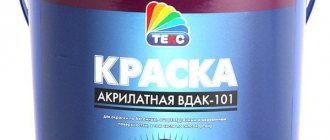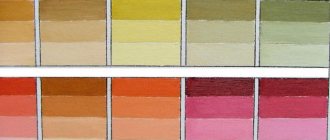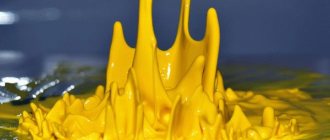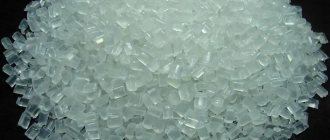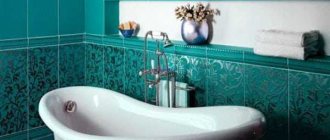Acrylic paint: does it need a varnish layer?
The acrylic-based coloring composition has a water-dispersion base. The main binder (polyacrylates, polymers of various compositions) is distributed in water, but does not mix with it and does not enter into a chemical reaction. In addition to acrylates, the composition includes a surface-active additive (plasticizer) and an antiseptic.
The plasticizer is responsible for the formation of a protective surface film. Thanks to this additive, the coating is resistant to wear, mechanical damage and moisture. Acrylic dye is environmentally friendly, dries quickly, and many people find that it creates an impenetrable layer once dry. This is only partly true.
Acrylic is characterized by thermoplasticity. This means that if the coating gets too hot (for example, under the sun's rays), it will reduce its strength, and it is quite easy to damage the softened layer. It has been repeatedly observed that if two acrylic coated surfaces come into contact, there is a possibility of them sticking together.
The varnish layer increases the attractiveness of the furniture Source archidea.com.ua
As the painted acrylic surface dries, water evaporates. The process proceeds quickly, and at the end of it micropores remain. If you apply a layer of varnish on top, it will harden, close the pores and increase the durability of the paint layer.
Varnish is applied to acrylic paint in many cases; for example, artists varnish paintings painted with acrylic. Finishing craftsmen try to varnish wooden surfaces; the same rule is used in furniture production.
Advantages and properties of acrylic
Acrylic has a huge advantage over other paints due to its diverse qualities. It combines strength and elasticity and adheres easily to surfaces for a long-lasting fit. A product coated with such varnish will easily withstand external influences, direct sunlight, frost, and excess moisture.
When varnishing residential premises, protection from mold and parasitic fungus is provided, and fire safety will also be observed.
This composition can be used to coat both plaster and brick walls to secure a positive result. The properties of the varnish include:
- no odor;
- interaction with water-soluble paints;
- quick drying;
- high resistance to the external environment;
- viscous consistency;
- unproblematic solubility in aqueous liquids;
- tight fit to clean surfaces;
- not afraid of contact with water after drying;
- Transparency is maintained when exposed to ultraviolet rays.
It is important to remember that not all acrylic paints respond equally well to the same type of varnish. For this type of dye, acrylic or polyurethane varnish is best suited.
On video: how to choose a varnish.
Varnishing: arguments for and against
Despite the fact that acrylic paint itself forms a durable and flexible coating, the answer to the question of whether acrylic paint can be varnished is often answered in the affirmative. Varnishing provides the following additional advantages:
- The painted surface receives additional protection from abrasion and moisture.
- The varnish layer prevents contamination, preserving the original characteristics of acrylic.
- Thanks to the varnish, the gloss of the surface is evened out, the color becomes brighter and more saturated.
- The varnish layer protects the base from fading under the influence of solar ultraviolet radiation.
The varnish composition is convenient to apply with a brush Source proekt-sam.ru
- The varnished surface is easier to care for.
The following arguments are put forward against varnishing:
- Acrylic is a polymer and was not originally intended for varnishing. If the varnish is applied carelessly, it can cause the base to peel off over time.
- The varnish layer complicates restoration work, no matter whether it is a painting, a wall or furniture.
See also: Catalog of companies that specialize in paints and varnishes and related work
Can varnish be applied to paint?
As a rule, wood is coated with this substance. However, sometimes there is a need to protect, provide additional gloss, hardness and strength to coatings made from other materials. In most cases, we are talking about water-based or acrylic paint.
The dye on the material must adhere firmly and retain its properties and color. The substance will help increase the strength of the prepared surface and enhance the shine effect. But a special composition should be used. It is recommended to use acrylic products that are odorless, quick-drying, and do not allow the paint to flow.
Do I need to prepare the painted surface for coating? Certain actions will still need to be taken. There should be no traces of dust, grease or other contaminants on the surface. Therefore, the painted base must be primed. You can find out how long it takes for the primer to dry on different surfaces from our article. In addition, the substance and dye must be compatible.
How do you know if the varnish product and paint are compatible? To determine their compatibility, the emulsion is lightly applied to the surface in an inconspicuous place, using a small area for the experiment, just for testing. If no negative changes are found on the surface, then the entire area can be varnished.
IMPORTANT! Do not apply the product to a wet surface. The item must be completely dry.
What to choose from: varieties of varnishes
The external selection criterion is the type of surface, which can be matte, semi-matte or glossy. You can be guided by the complexity of the composition, and according to this criterion, varnishes are divided into one-component (with acrylic as a base) and two-component, with an epoxy, alkyd or polyurethane additive. The composition classification is as follows:
- Acrylic varnishes. Homogeneous, ready-to-use, water-based liquid, transparent or milky in color. Used to protect wooden surfaces and for decorative finishing.
Water-based varnish for furniture and walls Source domingo.su
- Oily. The composition includes natural and artificial resins dissolved in turpentine (turpentine). Oil varnish is ideal for wood that absorbs oil mixtures well. The main disadvantage is the long (sometimes up to several days) drying time.
- Alkyd. They are obtained by mixing synthetic resins in organic solvents. Suitable for treating surfaces indoors and outdoors. They are convenient because they can be applied with any tool: brush, roller, spray gun.
- Nitrovarnishes (nitrocellulose). This is a solution of chemical components in a mixture of volatile organic solvents. This leads to the main properties: fast drying, good adhesion, toxicity (respirator required). Before starting work, a paint compatibility test is carried out.
- Polyurethane. Wood options have a reputation for reliable, durable finishes, regardless of wood species. They protect well from all types of influences, mechanical and weather. The disadvantages of the polyurethane composition are the high cost, multiplied by the complex application technology.
Glossy alkyd varnish for furniture Source absolut-dostavka.ru
- Epoxy. Epoxy resin in an organic solvent creates a durable waterproof layer, therefore it is used for varnishing wood in damp rooms (for example, in a bathhouse). The epoxy varnish layer can withstand alkaline environments, but lacks aesthetics.
Varnish for paintings: to cover or not?
No one will dispute the fact that Painting is one of the most amazing things ever invented by humanity! She, like an unusual beauty, transformed and improved, adapting to different eras of time.
It is not surprising that there are more and more lovers of paints and brushes in the world, because there are a huge variety of techniques and techniques for applying colorful strokes ! The 18th century thinker and philosopher Johann Goethe once said: “Painting is the most accessible and convenient of all arts.” Is not it?
Of course, there are more admirers of traditional oil painting, although recently many professional artists give preference to the new art - acrylic painting . But no matter what painting technique you choose, it is advisable to protect the painting upon completion of the work.
Painting is the most accessible and convenient of all arts.
This leads to a bunch of painful questions: “What varnish should I use to coat the painting?”, “Is acrylic varnish suitable for oil paintings?”, and perhaps the main question: “Should I varnish the painting, is it worth doing?”
If you decide not to cover your painting with a protective film, then there is probably some reason. Perhaps you don’t like excessive shine in the painting or don’t like visible brush strokes or... In principle, you can endlessly philosophize on the topic of covering a painting or not and find a bunch of arguments for and against.
Let's discuss these and other questions in this article, and decide whether it is worth covering the painting with varnish , what are the advantages of oil painting under a varnish film.
Protection of the paint layer from external factors
Varnishing a painting is necessary , first of all, to protect the painting from moisture in the air, sunlight and smoke. In addition, the varnish film protects the painting from mechanical damage, minor scratches and abrasions.
And don’t forget that dust settles on oil painting over the years and makes the paint dull and inexpressive. And it’s not customary to talk about this, but oil paints retain traces of the vital activity of flies, and this has a detrimental effect on the brightness of the paints.
A layer of varnish improves the picturesqueness of the picture, makes the colors brighter, more expressive and deeper, reveals small details, as if giving volume to the image.
But sometimes you can hear the opinion of contemporary artists that varnishing is not at all necessary, that it is, as it were, a tribute to modern fashion, a love of gloss.
They say that my paintings look so good, the colors are rich, in my painting I use an excellent “tee”, which includes varnish. There is some truth in this, because we know that earlier the composition of oil paints was completely different, they were prepared mainly from pigment and nut oil, which was a solvent. Therefore, painters always coated their paintings with varnish to make the painting more durable, and also to even out the glazes in multi-layer painting.
The fact that previously all paintings were covered with varnish can be said with confidence by restorers who restore paintings by old masters. Restoration of paintings begins with the removal of the old yellowed varnish that covers the canvas.
Removing old varnish from an antique painting
Well, if you read the history of painting, you can learn a lot of interesting things! For example, there are written sources from the 8th century containing recipes for preparing varnish based on linseed oil and several natural resins. Any drawings and even wood carvings were covered with this mixture.
The genius of his time, Leonardo da Vinci, in his Treatise on Painting, writes about the use of “eternal varnish” to cover an already dried layer of paint. And even shares the composition of the ingredients with the future generation! He recommended using amber nut butter or sun-aged nut butter until thick. The old masters still thought about the eternity of their paintings!
Secrets of painting by the old masters
Moreover, they constantly invented new recipes for varnishes, which were kept in the strictest confidence! Did you know that painters kept the secrets of their craft not only regarding the production of paints and varnishes, but also the use of a camera obscura in painting. In principle, today this is no longer a secret, and in his “Treatise on Painting” Leonardo da Vinci also mentioned this miracle - optics.
Now everything is simpler, the choice of topcoat varnishes for oil and acrylic painting is huge, there is no need to invent or invent. All you have to do is go to an art store and buy a suitable varnish, a wide brush/flute, and you can varnish the painting yourself.
Read how to coat an oil painting with varnish ⇒ in the instruction article ⇐ There you will find answers to the most frequently asked questions.
Modern topcoat varnishes for painting are made on the basis of natural or synthetic resin and solvent. Now let's figure out which varnish is best to coat the picture? How to choose exactly what will make the painting more durable and protected?
Huge selection of protective varnishes for paintings
- The most common painting varnish based on natural resin, used since the 19th century, is dammar varnish. This varnish is good for everyone: natural, relatively inexpensive. There is one drawback: over time, the varnish coating acquires a slightly yellowish tint. But if the picture is painted in warm colors, this nuance can give the painting nobility and aristocracy!
- Today you can choose another option - acrylic synthetic varnish for paintings . Depending on the composition, it can be acrylic-pistachio or acrylic-styrene. Although many foreign manufacturers simply write Acrylic varnish for paintings , specifying only what kind of painting it is suitable for. In the photo above I gave such an example.
Coating the painting with acrylic varnish does not cause yellowing; the result is a delightful varnish, elastic and durable film. The color and brightness of the paint under acrylic varnish does not change. This coating will protect the painting from high indoor humidity because it has excellent water resistance. True, it is a varnish with a strong smell, as it is made of synthetic resins.
To protect my works, whether in oil, acrylic or mixed media, I use acrylic universal painting varnish. But it happens that I varnish acrylic painting with varnish only for acrylic painting, where the composition is different and the end result is different.
By the way, many artists believe that it is more interesting and artistic to express their creative nature in mixed media. You can read about this very interesting technique in a separate article⇐
Coating varnishes for paintings also differ in appearance. They are produced by domestic and foreign manufacturers in glossy and matte finishes. Which one is better to choose?
Examples of glossy and matte varnish for paintings from a French manufacturer
All glossy and shiny varnishes give glare - this is a minus for painting, but they add brightness and depth to the colors and this is a definite plus!
Interference with glare from the window
It is difficult to examine the entire picture if the light falls on it, for example from a window, but from a certain angle it is still possible. If you have been to museums or art galleries, you probably noticed this.
In the photo I am trying to “capture a moment” next to an old painting in the style of a Dutch still life with yellowed old varnish. The large painting from a private collection will eventually require restoration, but for now it hangs and decorates the dining room in the house.
Matte varnish for paintings also protects the painting, and in addition, it makes the painting surface seem velvety, velor. If the painting is located in a room with bright daylight, it is recommended to choose topcoat varnishes with UV filters. As a rule, this quality is indicated on the packaging. Filters protect paints from fading and tarnishing.
Difference between gloss and matte varnish
There are also satin varnishes , this is something between a matte and glossy option. If matte varnish has no shine effect at all, and glossy varnish is very shiny, then satin varnish has a moderate shine, which is good! I have not seen this option from Russian-speaking manufacturers. In addition, you can come across a description that seems like matte and satin are the same thing. Believe me, this is not true, that’s why they have different names! Satin translates as satin, satin or semi-matte. Paintings coated with satin varnish really look like satin. It is difficult to convey the subtlety of varnishes from a photo; you need to see it with your own eyes to feel the difference.
Examples of satin/Satiné and glossy/Brillant varnish from a French manufacturer
In the photo above, I indicated the name of the polishes in French with an arrow to convince you of the veracity of my words. Note: It is not recommended to cover the painting with varnish that has been left in stock. Expired painting varnish can ruin the painting; it dries poorly or retains a sticky surface for a long time without drying to a glossy finish; it can also leave the brush visible on the canvas.
Advanced artists sometimes cover their paintings with a medium; there are ready-made materials that are sold in art stores. The medium guarantees the durability of the color, and also gives the paints volume and a relief effect. Of course, to use such a technique, you must be completely confident in your abilities and know the technique.
Today on the market you can find topcoat varnishes in cans. This is especially convenient if you write in relief or mixed media. At one time I tried this option of applying protection to the surface of the canvas. The varnish consumption is greater than the traditional method, but it applies smoothly and does not create smudges or other troubles, for example, lint coming out of the brush.
Universal varnish in a can to protect paintings
Friends, I hope my little tips will help you in your creativity and I have dispelled some doubts about whether or not to varnish a painting. If such arguments for and against do not seem enough to you, then ask them to art restorers. Perhaps their point of view will be more convincing!
For dessert: for those who like to wander through exhibitions of contemporary art, I invite you to do this with me on the Cote d'Azur in France in the city of Cannes. Like and don't forget to subscribe to my channel to keep up to date with the news.
To prevent the article from getting lost on the Internet among many other articles,
just save it in your bookmarks, and you will always have it at hand at the right time.
Ask your questions below in the comments, I usually answer all questions quickly
I recommend reading similar articles:
What is suitable for acrylic
If the question arises about what varnish can be used to coat water-based acrylic paint, it is important to understand that two types of varnish are used for acrylic-based paints:
- Based on mineral alcohol. A volatile composition that requires respiratory protection and high-quality ventilation when working with it.
- Water-based (polymer). The composition is used exclusively for acrylic paints. It is safe, easy to apply and can be removed with ammonia. Acrylic varnish is fully compatible with the same paints.
Varnishes also have other characteristics, so when choosing, you will have to decide the following questions:
- The composition will be used for outdoor or indoor work.
- What level of gloss is preferable? You can get a glossy, matte, satin surface.
Varnish compositions scatter light with different intensities Source semi-art.ru
- The varnish is permanently applied or you are considering removal.
- Liquid or spray form is best for you.
Areas of application of acrylic
Due to its unique qualities, acrylic varnish is widely used in repair and construction work, often instead of conventional paint.
Varnish is widely used in repair and construction work
Main areas of application:
- Decorative wood finishing. Acrylic also protects wood from pests and mechanical damage, and also increases its moisture resistance.
- Acrylic compounds are widely used in construction. The varnish is popular due to its fast drying and color stability.
- Household and interior elements. Acrylic is used to process various interior elements, such as furniture, stairs, railings, etc.
- There are special varieties for finishing yachts. They are especially resistant to moisture and temperature changes.
- Raw materials for the production of building mixtures and adhesives.
Which varnish composition is better to choose?
Acrylic varnish, which is fully compatible with the coloring composition, is more expensive than synthetic analogues. It is used if the appearance of the item has special significance, for example, a painting or a piece of furniture made for sale. If staying within your budget is important to you, you should stick with regular wood varnish. Before purchasing, you should study the label to find out the following points:
- Will the coating protect against moisture?
- Will the varnish layer be UV resistant and how quickly will it dry completely?
- The composition is permanent or removable.
- Is the varnish elastic or hard? Stretch film is suitable for flexible substrate (wood or canvas) that changes dimensions; it will not form cracks due to changes in temperature and humidity. Hard varnish is used if acrylic is applied to a hard wooden surface.
After drying, the varnish coating becomes transparent Source vitospb.ru
Instructions for coating with varnish
The work consists of several successive stages.
Stage one: choosing varnish
First of all, you need to find out whether the varnish is suitable for the existing base (wood, putty, plaster). It is recommended to deal with a fresh composition of varnish with acrylic elements. Fresh means that 3 months have not passed since the date of its release. It is advisable to give preference to a matte composition over a glossy one, since acrylic usually does not need to be given shine.
First of all, you need to choose the right varnish for the surface to be treated.
Stage two: preparatory
We remove the protective component (film, glass or the like), and so as not to disturb the acrylic base. If dust is detected, it must be carefully removed. It is better to do this with a vacuum cleaner or even a feather broom.
Note! It is strongly not recommended to use rags made from coarse fabrics, as acrylic is very sensitive.
Even before use, the varnish must be heated to 40-50 degrees. The best way to do this is using the water bath method. If it is not possible to measure temperatures, then the rule applies: 3 liters of paint and varnish composition are heated to the desired temperature in approximately 5 minutes. When heating, the composition must be stirred, for example, with a lath.
Stage three: varnishing
First of all, you need high-quality lighting. The light should come from above and to the right. It is recommended to apply the composition with a flute brush 50-150 millimeters wide. The brush is lightly dipped in varnish, then the surface is treated with sweeping but smooth strokes. After processing approximately 0.5-0.7 square meters, the applied layer must be polished.
Polishing is done with a dry brush and as soon as it begins to stick to the surface, you can begin varnishing other areas.
Note! The treated surface must be protected from dust until the varnish hardens.
Techniques for high-quality varnishing
The varnish is applied in two or three steps (with intermediate drying) in any convenient way: with a brush, sponge, spray gun. To ensure a high-quality result, you need to remember the following nuances:
- The surface coated with acrylic paint must dry completely. Depending on the thickness, the process can take from three days to two weeks (full strength gain takes 30 days).
- When choosing a varnish mixture, the quality of the surface is taken into account. Irregularities are more noticeable under the gloss, while the matte layer hides them.
- Pre-priming the surface will reduce varnish consumption. A water-based primer will do.
- Acrylic varnish is diluted only with water (preferably distilled), and water by volume should not exceed 10% of the composition itself.
The primer will help save varnish consumption Source gidpokraske.ru
Useful tips
- To optimize varnish consumption, surface priming is recommended. To do this, you can use a water-based primer or tinted impregnation.
- If the goal is a “mirror” surface, you need to “wet” sand before priming, which means sanding wet wood.
- Also, the specularity is imparted by treating all layers of varnish (except the last one) with fine sandpaper.
- When choosing a paint product, you need to take into account the presence of defects on the surface. For example, glossing visually increases existing unevenness, while a matte background conceals it.
- Acrylic can only be diluted with clean water. Moreover, the volume of water should not exceed a tenth. Do not dilute water-based varnish with organic solvents or mix it with drying oil or other varnishes. Violation of these rules leads to wood losing its natural structure.
- Varying shades in a can of tinted varnish are normal. However, the composition must be stirred well before use.
- Acrylic varnish cannot be used if the air humidity is less than 50%, since in this case it dries too quickly, which will cause defects.
- Do not varnish oily surfaces. They must be pre-treated with soapy water and then dried.
- To give the wood a noble shade, it must be treated with tinting impregnation, and after that - with colorless varnish or varnish mixed (5%) with water impregnation.
- When applying tinted varnish, it is necessary to ensure that the layer is even, because if it is too thick, it will make the surface look dark.
- Several thin layers will contribute more to the uniformity of the coating rather than one thick one.
- To add darkness, you can first make the first layer very thin, and the next one should be colorless.
- If the goal is uniform varnishing, the old layer of varnish needs to be completely stripped off or a dark varnish should be used.
- To even out the absorbent qualities of the wood, it is primed with a couple of layers of colorless impregnation or then tinted.
Before starting paint and varnish work, it is recommended to try your skills on some test product. It is better to move on to responsible tasks as you gain some experience.
Briefly about the main thing
Acrylic paint varnish is used in cases where they want to further protect the paint layer or give it a more presentable appearance. The best choice for this procedure would be a water-based varnish composition.
When purchasing, you need to pay attention to its qualities: ultraviolet resistance, elasticity, and removability. The varnish layer is applied to the acrylic after it has completely dried; If dilution is needed, use only water.
Ratings 0
The process of painting over varnish
Surface preparation
The peculiarity of applying paintwork over varnish is the preparation of the base. First of all, you need to make sure that the old coating is securely attached to the base and is not peeling off or crumbling.
The work is performed in the following order:
- First of all, the surface is sanded with fine sandpaper until it acquires a matte surface.
- Then the cleaned surface is treated with a degreasing liquid.
- After this, a special primer is applied to the surface - a primer for painting to improve adhesion. The composition is distributed in a thin layer over the entire surface. For these purposes, you can use a brush, roller or spray. As a rule, the primer is applied in two layers. More precise information on how to work with the primer is contained in the instructions on the packaging.
Advice! In order not to apply paint and varnish material over the varnish, the old coating can be removed using a hair dryer and a spatula.
In the photo - sanding the surface
Stages of painting a wooden base
- Having chosen a paint, pay sufficient attention to preparing the base. If the old varnish crumbles and peels off, the problem areas must be cleaned down to the wood. It is enough to sand the rest of the surface until a matte texture is obtained, then remove the dust with a vacuum cleaner and degrease it with the composition recommended in the instructions for use of the paint.
- The texture of an alkyd varnish coating can be spoiled by unprofessional application of several layers of varnish. The defect is difficult to correct, but necessary. To remove several layers of varnish, use a hair dryer and a spatula. The mass of varnish heated by hot air is easily removed by its working edge.
Note!
A primer will help improve the adhesion of paint to the varnish base - this is the name of a special primer that is applied to the wood in two layers. For varnish coating, a one-time treatment will be sufficient. There are many types of primer, so look for a solution recommended by the paint manufacturer.
- Apply the first layer of paint of the main shade. Most often, lacquered furniture has a deep brown color, so the base layer, through which dark wood is visible, should be light.
- After the first layer has dried, apply the next layer of the main color.
- Next, we paint the furniture facades with a contrasting shade. In this case it will be coral.
- After the paint has dried, the entire surface along the borders is sealed with special masking tape. The borders are spray painted with a different shade.
- The corners are sealed with overlapping masking tape, which is best cut into the required fragments with scissors.
- Now you can paint the borders with spray paint and remove the tape.
- The handles and key to the cabinets are painted gold to match the borders.
What options does the range of compatible paint materials offer?
Environmentally friendly water-dispersed silicone-based paints meet all the requirements for strength, resistance to external influences and durability that apply to high-quality protective and decorative coatings.- Environmentally friendly silicone materials are produced in a wide range of colors.
- Having good adhesion to any substrate and excellent light resistance, the silicone coating is applied without drips or streaks, dries quickly, and can be used outdoors without any problems.
- Very weather-resistant alkyd enamels are characterized by a bright, rich color, are easy to work with, and can be used for exterior and interior use.
- The cost of alkyd enamels is lower than silicone paint, but when applying it, it is recommended to install temporary exhaust ventilation and use protective masks or respirators.
- The characteristic odor of the solvent can be felt indoors for several days. And therefore, upon completion of work, it is advisable to ventilate the house more often. In the best case, it is better to postpone the decor update to the warm season.




